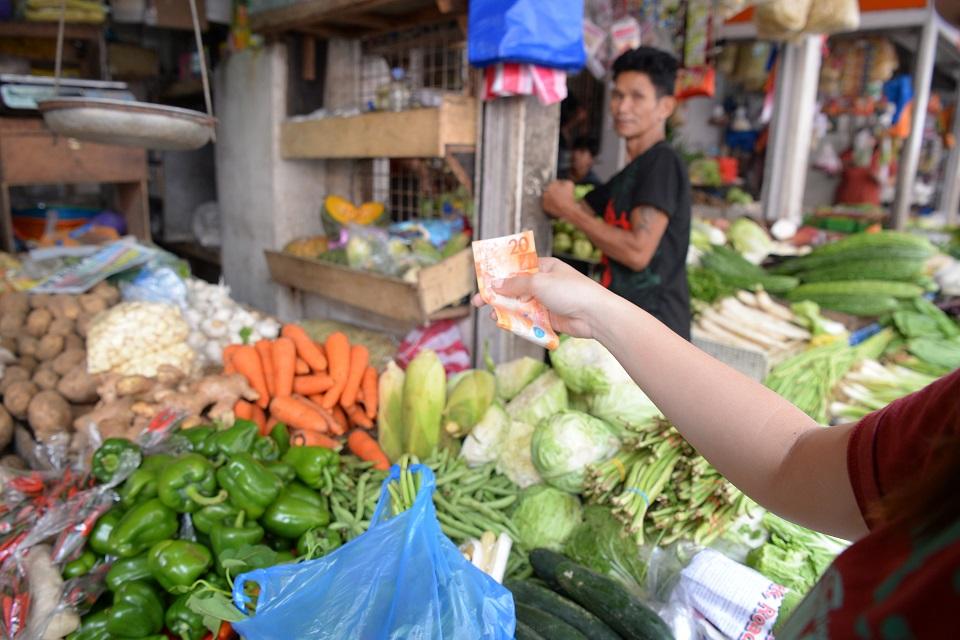Inflation snaps 4-month deceleration streak, rises to 3.4% in February

The Philippines’ inflation rate ended its four straight months of slowdown in February amid the faster rise in food, transport, and utilities costs, the Philippine Statistics Authority (PSA) reported on Tuesday.
At a press briefing, National Statistician and PSA chief Claire Dennis Mapa said that inflation —which measures the rate of increase in goods and services— accelerated to 3.4% in February 2024, faster than the 2.8% rate in January.
Year-on-year, February’s inflation rate was slower than the 8.6% rate seen in the same month last year.
Last month’s inflation print snapped the four-month deceleration streak which began in October last year.
Year-to-date inflation rate stood at 3.1%, falling within the government’s ceiling of 2% to 4%.
February’s inflation rate also fell within the Bangko Sentral ng Pilipinas’ forecast range of 2.8% to 3.6%.
Contributors

Need a wellness break? Sign up for The Boost!
Stay up-to-date with the latest health and wellness reads.
Please enter a valid email address
Your email is safe with us
The top contributor to the faster inflation in February was the Food and Non-Alcoholic Beverages index, which saw an inflation rate of 4.6% up from 3.5% month-on-month.
Mapa said the Food and Non-Alcoholic Beverages index contributed 69.5% to the overall acceleration in February.
The swifter inflation for the index was due to the faster increases for vegetables at -11% from -20.8%, the rise in meat prices from -0.7% to 0.7%, and cereals and cereal products at 17% from 16.3%.
Also contributing to the acceleration was the Transport index, which grew to 1.2% from -0.3%. Transport contributed 22.7% to the overall uptrend.
This as gasoline and diesel saw their respective inflation rates rise to -1.7% (from -6.3%) and -3.5% (from -12.1%) during the period.
The third top contributor to the faster inflation print February was Housing, Water, Gas and Other Fuels index which saw an inflation rate of 0.9% from 0.7%, contributing 7.2% to the overall rise.
This was due to the increase in electricity from -10.2% to -7.4% and rentals from 3% to 3.1%.
Meanwhile, food inflation —which tracks price movements in a “basket” of foods commonly purchased by households— climbed to 4.8% from 3.3% month-on-month due to higher rice and meat prices but was tempered by slower increments in fish and milk, dairy, and eggs at 0.7% (from 1.2%) and 3.5% (from 5.6%), respectively.
Rice: Main culprit
The PSA chief said rice, which saw an inflation rate of 23.7% in February, was the “major contributor” to the overall inflation, contributing 1.6 percentage points of the 3.4% overall inflation rate in February.
This was also the highest inflation print for the food staple since February 2009 when it clocked in at 24.6%.
Mapa said the faster rice inflation is seen to persist until July or August this year.
Inflation for bottom 30%
Inflation rate felt by the bottom 30% income households in the country also rose to 4.2% from 3.6% due to faster increase in Food and Non-Alcoholic Beverages index at 6.4% from 5.2%.
Mapa said rice is the main contributor to the higher inflation for the income class, contributing 3.3 percentage points to the overall inflation for the bottom 30% of income households.
The Transport index also posted an increase of 1.8% from 0.3% for the income class’ inflation while Housing, Water, Electricity, Gas and Other Fuels index saw a decline of 2.8% from 3.1%.
In a separate statement, National Economic and Development Authority Secretary Arsenio Balisacan said the government will continue monitoring food supply and prices and implement necessary policies and strategies “to ensure affordable and adequate food for Filipino families, especially those from the most vulnerable sectors.”
“As we navigate the economic landscape, it is imperative that we remain vigilant and proactive in our approach to managing inflationary pressures. While we have seen some relief from certain inflation risks, we must not become complacent. The potential impact of a strong El Niño weather pattern on food prices is a significant concern for our community,” Balisacan said.
“Rising transportation costs, electricity rates, and volatile oil markets are putting pressure on household finances. Our team is actively formulating robust strategies with the concerned agencies in response to these challenges. We must be agile, adaptive, and forward-thinking,” the NEDA chief said.
The BSP, for its part, said that the 3.4% overall inflation rate seen in February is consistent with its expectations that inflation will likely remain within the target range in the first quarter of 2024 due largely to negative base effects.
“However, inflation could temporarily accelerate above the target range from the second quarter of 2024 due to the adverse impact of El Niño weather conditions on agricultural production and positive base effects,” the central bank said.
The BSP added that risks to the inflation outlook have receded but remain tilted toward the upside.
“The upside risks to the inflation forecasts are linked mainly to higher transport charges, increased electricity rates, higher oil and domestic food prices, and the additional impact on food prices of a strong El Niño episode. Meanwhile, the implementation of government measures to mitigate the impact of El Niño weather conditions is the primary downside risk to the outlook,” it said.
The BSP said its Monetary Board deems it “appropriate” to keep the monetary policy settings unchanged in the near term amid the improvement in inflation conditions.— RSJ/ VAL, GMA Integrated News

Need a wellness break? Sign up for The Boost!
Stay up-to-date with the latest health and wellness reads.
Please enter a valid email address
Your email is safe with us





